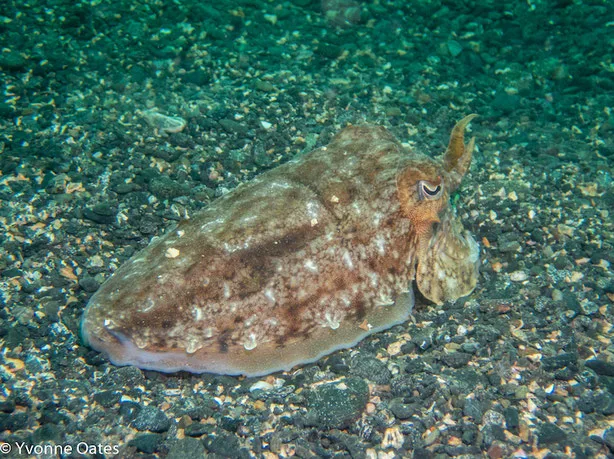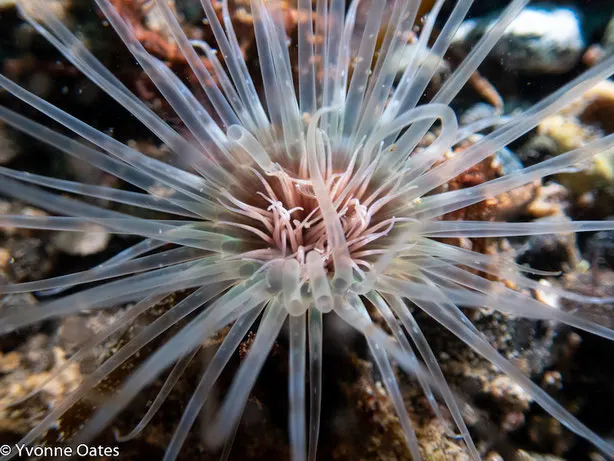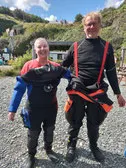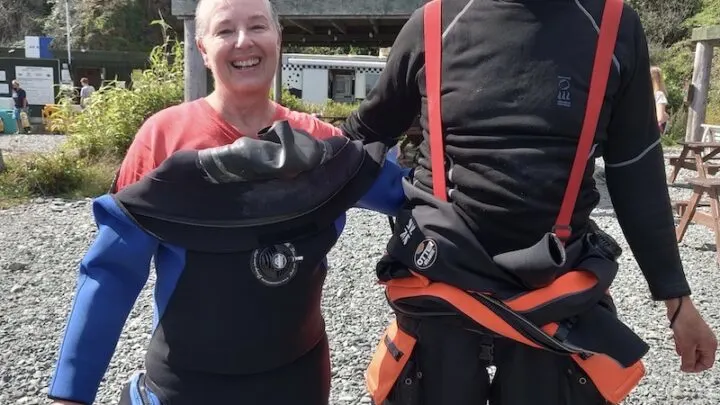Like many of us, my travel and diving plans for this year have changed, and I’m in England. I’ve never dived in UK waters before, but it’s been a year since I last dived, and I’m very much missing the ocean! When GTS announced a snorkel with seals day trip to Lundy Island in Devon, I decided to book that, extend my trip, and push my comfort zone by booking a drysuit certification.
As always with scuba questions, I asked the hive mind on the GTS FB group for advice, and settled on Porthkerris Divers.
Trying on drysuits and what to wear underneath
I’m sure there are plenty of excellent dive shops in Cornwall, but Porthkerris came with many recommendations. I emailed them and booked a date. The course is just one day, with two dives.
I had asked in advance by email what I should wear under the suit, as I didn’t plan to buy specific dry suit undergarments. Porthkerris Divers advised a warm comfy top/bottoms, such as a fleece, and socks. They also advised that they stock Fourth Element undersuits for purchase.
I went into the dive shop the day before, to complete paperwork and try on rental suits for size. Yup, sizing drysuits for women is just as challenging as sizing in wetsuits! Of course it’s difficult for a dive shop to stock every possible size of rental suits, but it is frustrating for a woman. We started with shoe size, and I began to try on a suit with integrated boots that were my shoe size. It very quickly became clear that there was no way I was going to get that suit over my knees, and I don’t think I’m an unusual sized woman – I’m 5’3” and 78 kgs (172 pounds).
We moved on to a larger suit. I pushed my feet down into the boots and they were clearly at least two sizes too big for me (I had one pair of socks on). Ok, let’s try the rest of it. Slowly peeling and pulling the legs up. Hips, bum and tum: yeah here we go! It was definitely a tight fit getting the suit up to my waist, but I managed.
Under the dry suit I wore 1 pair of socks (which I then upped to 2 pairs for the actual dives), cotton leggings, thin T shirt, thin cashmere sweater. I had a fleece with me, but decided not to wear it for diving, as the air temperature was pleasant, and the water temp was about 16C. I also had my 3mm hood, and took gloves in a pocket, but didn’t actually use them.
The suit I was trying on was crushed neoprene, with a horizontal back zip across my shoulders. So now to the really fun part – getting my arms and head in – this is where I really needed help! Arms first, ok, now the head. There is of course a tight latex seal around the neck to stop water getting in, and that makes it feel like being born again, to push your head through! My instructor zipped me up behind, and I tried to flex and move around. The suit was tight around my bum and tum, the neck seal was tight, but I could breathe. The boots were definitely too big. But this is the best fit for me, out of the rental suits available. I was given the PADI dry suit certification manual, and went away to study!
How to use the drysuit and my concerns
I had already done a fair amount of reading of other divers’ experiences of using dry suits, and I was fully expecting to feel like a complete newbie diver, flailing around, struggling with buoyancy. I had been warned about floaty feet and tricks to get back the right way up! I was pretty apprehensive, but decided I was just going to laugh it off if I turned upside down and couldn’t right myself!
I arrived on the Saturday morning and met my instructor David Roberts, and we started talking about how to use a dry suit. Dry suits typically have an inflator valve in the chest area, to which you attach a low pressure hose, just like the one you attach to your BCD. So with a dry suit, you’ll have two low pressure hoses on your reg set up. There is also a dump valve, usually on the left shoulder or wrist. My dry suit had the dump valve just above the left wrist. I usually wear my dive computer on my left wrist, but switched it to the right wrist for these dives. Another thing to remember. We discussed use of dry suit, BCD or lungs to control buoyancy, and David explained that as I started to descend I would very quickly feel the squeeze in my dry suit, so I should press the intake valve on my chest to let some air in to relieve that squeeze.
Our dive was planned to be quite shallow, our maximum depth was less than 8 metres, so although I should consider using my BCD to compensate for extra pressure at depth, I would probably not need it on these dives. And of course, as always, I needed to be aware of letting air out of both BCD and dry suit, as I ascended.
My first drysuit dive

David suggested that I would need 10 kgs of lead. This was to be a shore dive, with a short walk down a rocky slope, with a rope handrail fixed. Well I’m a reasonably fit and strong 64 year old, but I decided to ask for help. I knew there was no way I was going to be able to walk down that rocky slope with all my gear.
David and his co-instructor Andy (yes I had two instructors!) were happy to help out. I got myself down the slope, got my BC and tank on, plugged in the low pressure hose to my suit’s inflator valve, and crunched over the pebble beach to the water line.
David and Andy told me to start wading in, then to lie on my back, while they put my fins on – gold service here! But seriously, I don’t see how anyone could possibly get their own fins on, wearing that thick, crushing dry suit (and BC and tank). I definitely started to feel the squeeze in the suit very soon, so I popped the chest valve and puffed in a little air. This is something you have to judge by feel, you need enough air in the suit to stop the squeeze, but not too much that you become too positively buoyant.
We carried on swimming and descending gradually. It was a strange sensation to be in water, to feel my hands and head get wet, but to realize that my body was dry and comfortable. Visibility was about 3-4 metres, and there was a fair amount of kelp, which I have dived in before in California and New Zealand (both also very cold water!) As we descended, I continued to slowly, cautiously add air to my suit, as I felt the squeeze progress. Sometimes I put a little too much in, and then I held up my left arm and felt the bubbles vent out – the dump valve is automatic and just requires that you raise your arm up. I was pleased and surprised to find the air adjustments fairly easy. I was afraid it might be a massive see-saw effect.
Drysuit Skills
There were a couple of skills to do. David demonstrated the classic fin pivot, which I copied quite decently, using my breath rather than air in the suit. The other skill is to take off, then replace, the low pressure inflator hose connector to the valve. I found that fiddly and tricky. My hands were cold and the connection was stiff. David had to move it around a bit, and then I finally managed to do it myself. If I had been wearing gloves, I think that would have been even harder, even if my hands might have been less cold.
Because my boots were too big, even with two pairs of socks, air tended to collect in them, and so I got floaty feet a few times. I also felt like my boots and fins were slipping off, and indeed they were, as Andy swimming behind me, helped out by pushing my fins back on.
As we ascended slowly, swimming back to shore, I made sure to fully deflate my BCD, and also kept my left arm raised, so the auto-vent would gently bubble out the air from my dry suit. Once we were at the surface, I inflated my BCD, and stumbled back ashore. I was thrilled to hear David and Andy congratulate me on my outstanding buoyancy control! They kept saying they would never have believed that was my first dry suit dive! I was very pleased with their reactions.
My 2nd Drysuit Dive

New tanks, gear back on, in for the second dive! Andy had other things to do, and we were joined by a regular diver at Porthkerris, Yvonne Oates, who is also a keen photographer, and kindly shared her photos from this dive.
On the first dive, I had wondered if I was a bit over-weighted, and David suggested light ankle weights to help with the floaty-feet, so we dropped 2 kgs off the weight belt and added ankle weights.
After a few minutes, I felt that my right arm was definitely getting damp and cold, yup the wrist seal – wrapped up with duct tape – was gently leaking. Then I realised that my chest was cold and damp, another leak. I very quickly began to get cold. If dry suits leak, you definitely feel the cold.
I struggled a little more on the second dive with the balance between having enough air to avoid suit squeeze, but not too much to make me positively buoyant. I probably needed those 2 kgs I had dumped after the first dive. You definitely need lots of lead diving dry!
However, I managed to maintain decent buoyancy and trim on this dive, and despite the poor visibility I enjoyed the underwater life that David pointed out with his torch.
What I’m taking away (and tips for you) from my first time drysuit diving
My biggest takeaway from my first dry suit dives, it’s important to have a suit that really fits you well. It’s not just a comfort and keeping-dry thing, if your boots are big to make sure the rest of the suit fits, then you’re likely to get floaty feet, which can be tricky in a dry suit. If you’re going to buy your own dry suit, it’s probably worth spending a bit more to get a custom one.
PRO-TIP: don’t wear underwear! An underwater wedgie is very uncomfortable, and impossible to fix!
5 September 2020: two dives: 7.9 metres max, 37 minutes dive time, and 12.5 metres max, 34 minutes dive time. PADI dry suit certification achieved! Porthkerris Divers, Cornwall, England. All photos courtesy of Yvonne Oates.

About the Author
Danila Mansfield has been diving in mostly warm waters since 1996. She has been a nomad and blogs about it at www.notdunroamin.com She’ll be back travelling again one day!

